INTRODUCTION
According to the World Health Organization, the prevalence of chronic pain was approximately 22% worldwide [
1]. Due to prolonged life expectancy and an increase in the proportion of older people in the society, the number of people suffering from chronic pain is expected to increase continuously [
2]. Acute pain can have a protective effect on the body whereas chronic pain has a negative effect on the quality of life. Chronic pain may lead to a decrease in daily activities and an increase in cardiovascular complications, depression, and sleep disturbance [
3-
5].
Treatment of underlying causes is necessary to relieve pain; however, it is impossible in many patients who have intractable pain. Pain can be chronic and severe in some patients, and thus, non-opioid analgesics such as acetaminophen or non-steroidal anti-inflammatory drugs may not provide adequate pain relief. Opioids are the most potent analgesics, and an opioid therapy can effectively reduce chronic pain and improve the health-related quality of life in patients with intractable pain. Guidelines from both the Neuropathic Pain Special Interest Group of the International Association for the Study of Pain and the European Federation of Neurological Societies Task Force recommend opioids as the second- or third-line treatment for neuropathic pain [
6,
7]. In addition to advantages, opioids have disadvantages that include pharmacological side effects and socioeconomic problems such as addiction and misuse [
8]. According to a systematic review of opioid use for non-cancer pain, dry mouth, nausea, and constipation were the most common adverse events [
9]. Opioid treatment was discontinued in a substantial proportion (22%) of patients because of adverse events [
9]. However, more than the evidence-based concerns, misconceptions about opioids may interfere with the necessary treatment for pain control. Some patients are reluctant to take pain medications due to fear of addiction and/or of being thought of as an addict, fear of analgesic tolerance, and side-effects [
10,
11]. Furthermore, some patients in Korea have a fear of addiction in regards to taking their prescribed opioid medications and some of these patients have shared this concern with their doctors [
12].
Opioid prescriptions are increasing in Korea. One survey suggested that opioid consumption rose from 1995 to 2000 [
13]. Another survey reported that the prevalence of chronic use of weak and strong opioids increased gradually from 2002 to 2015 [
14]. Recently, the American Pain Society officially shutdown and filed for bankruptcy due to issues regarding opioid medication and abuse [
15]. The Korean Pain Society conducted a survey to assess the perception of opioids (positive or negative), whether the patients distinguished between medically prescribed opioids and illegally distributed drugs, and if the patients would follow doctor’s instructions when opioids are prescribed to them. In the current survey, we investigated patients’ perception about opioids, and attempted to identify the problems associated with prescribing and taking opioids in South Korea.
MATERIALS AND METHODS
The ethical approval for this study was waived by the Institutional Review Board of the Konkuk University Medical Center (IRB No. 2019-12-014). The survey was conducted by the Publicity Committee of the Korean Pain Society from September through October 2018. On the basis of the results of this anonymous survey, this manuscript was drafted in 2019. Patients who visited a pain clinic in 14 university hospitals in Korea were asked to complete anonymous questionnaires about taking opioids. Patients were informed that the purpose of this questionnaire was to investigate the perceptions of Korean patients regarding opioids and there would be no personal advantages or disadvantages, irrespective of whether they agreed or disagreed with this survey. The survey was then conducted only with patients who agreed to the survey. Patients who did not agree to participate in the survey were excluded.
The questionnaire consisted of the following questions (
Appendix): sex, age, the disease a patient is suffering from, period of treatment, experience of being prescribed opioids, side effects after taking opioids, degree of explanation from their doctor when they were prescribed opioids, perception of opioids, relevance of the legally allowed and insured duration of opioid prescription and dosage, whether the participant accepted the prescription of opioids, and if not, the reason for refusing opioid therapy, their source of getting information about opioids, whether they could differentiate between medically prescribed and illegally distributed opioids, and the numeric rating scale (NRS) pain score for deciding to take opioids. We distinguished patients who were actually prescribed opioids from those who were not, and each group was asked different questions to identify differences between the two groups including the overall perception about opioids. Patients who were prescribed opioids were administered a questionnaire assessing the side effects experienced by them, the extent of information they received regarding opioids from their doctor, and how they perceived opioids. Furthermore, their opinions regarding current restrictions on opioid prescription were obtained. On the other hand, patients who were not prescribed opioids were asked regarding their source of opioid knowledge, and whether they would follow the doctor’s opioid prescription.
RESULTS
A total of 368 patients from 14 university hospitals completed the questionnaires. Distribution of the sex, age, disease, and treatment duration of patients who responded to the questionnaires are summarized in
Table 1. Of the 368 patients, 209 (56.8%, opioid group) were prescribed opioids whereas 159 (43.2%, no opioid group) were not prescribed (
Fig. 1).
Fig. 1
Have you ever been prescribed opioids? (asked in both the opioid groups).
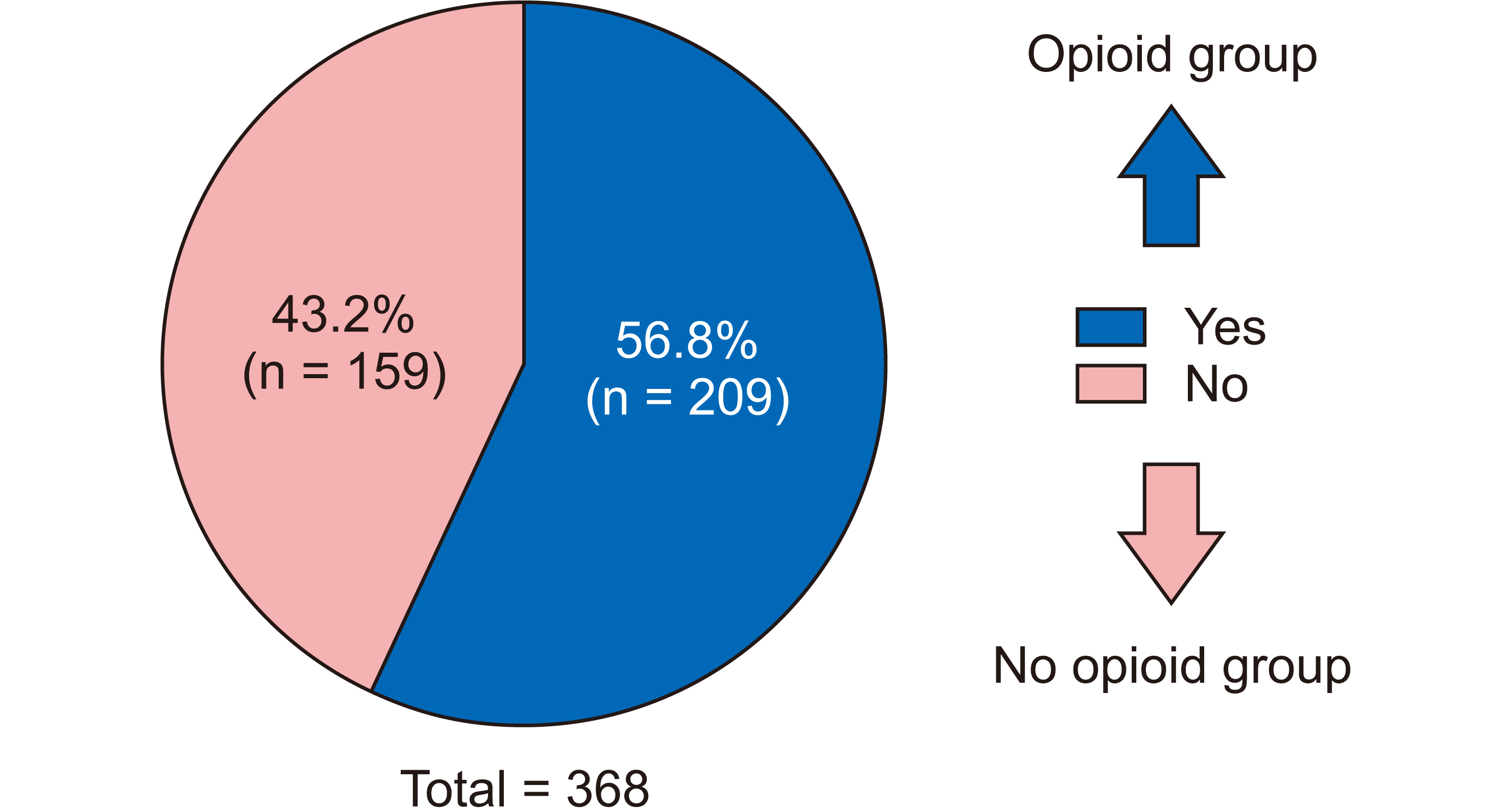

Table 1
|
Demographic variable |
Category |
No. of patients (%) |
|
Sex (n = 368) |
M |
172 (46.7) |
|
F |
196 (53.3) |
|
Age (n = 368) |
20s |
19 (5.2) |
|
30s |
66 (17.9) |
|
40s |
76 (20.7) |
|
50s |
83 (22.6) |
|
60s |
66 (17.9) |
|
70s |
41 (11.1) |
|
≥ 80 |
17 (4.6) |
|
Disease (n = 345, excluding 23 non-respondents) |
Spinal or joint pain |
166 (48.1) |
|
Complex regional pain syndrome |
76 (22.0) |
|
Postherpetic neuralgia |
40 (11.6) |
|
Fibromyalgia |
31 (9.0) |
|
Peripheral neuropathy |
26 (7.5) |
|
Cancer pain |
6 (1.8) |
|
Period of treatment (n = 366, excluding 2 non-respondents) |
< 6 mo |
99 (27.0) |
|
6 mo ≤, < 1 yr |
48 (13.1) |
|
1 yr ≤, < 3 yr |
76 (20.8) |
|
3 yr ≤, < 5 yr |
63 (17.2) |
|
5 yr ≥ |
80 (21.9) |

In the opioid group, the side effects after taking opioids were constipation (n = 69, 35.4%), dizziness (n = 48, 24.6%), nausea and vomiting (n = 34, 17.4%), dysuria (n = 12, 6.2%), addiction (n = 4, 2.0%), and others (n = 6, 3.1%). Twenty-two patients (n = 22, 11.3%) had no side effects (excluding 14 non-respondents) (
Fig. 2). In the opioid group (n = 206, after excluding 3 non-respondents), 161 patients (78.1%) received a good explanation about opioids and their side effects from their doctors, 30 patients (14.6%) received a rough explanation, and 15 patients (7.3%) did not receive any explanation. Among 201 patients (excluding 8 non-respondents), 21.9%, 50.7%, 20.9%, and 6.5% of patients had a very positive, positive, neutral, and negative or very negative perception of opioids, respectively (
Fig. 3). In the opioid group, among 200 patients (excluding 9 non-respondents), 20 (10.0%), 46 (23.0%), 18 (9.0%), 100 (50.0%), and 16 patients (8.0%) were prescribed opioids for 1, 2, 3, 4, and above 4 weeks at a time, respectively. Currently, opioids can only be prescribed for up to 30 days in Korea, because of the public healthcare insurance limitations. When patients in the opioid group were asked about their opinion on opioids, 203 patients responded (excluding 6 non-respondents), 104 (51.2%) of which thought they were suitable, 84 (41.4%) thought that the government should increase the maximum duration of prescription allowed, and 15 patients (7.4%) thought that they should be decreased. Among the respondents who answered that the duration limit should be increased, 78.6% cited patients’ convenience as the reason, whereas proponents of a reduction in the limit (excluding 2 non-respondents) cited concerns about abuse and addiction (n = 6, 46.2%) and the need for monitoring of effects and side effects (n = 7, 53.8%) as reasons (
Fig. 4).
Fig. 2
What are the most severe side effects that you have experienced? (asked in the opioid group).
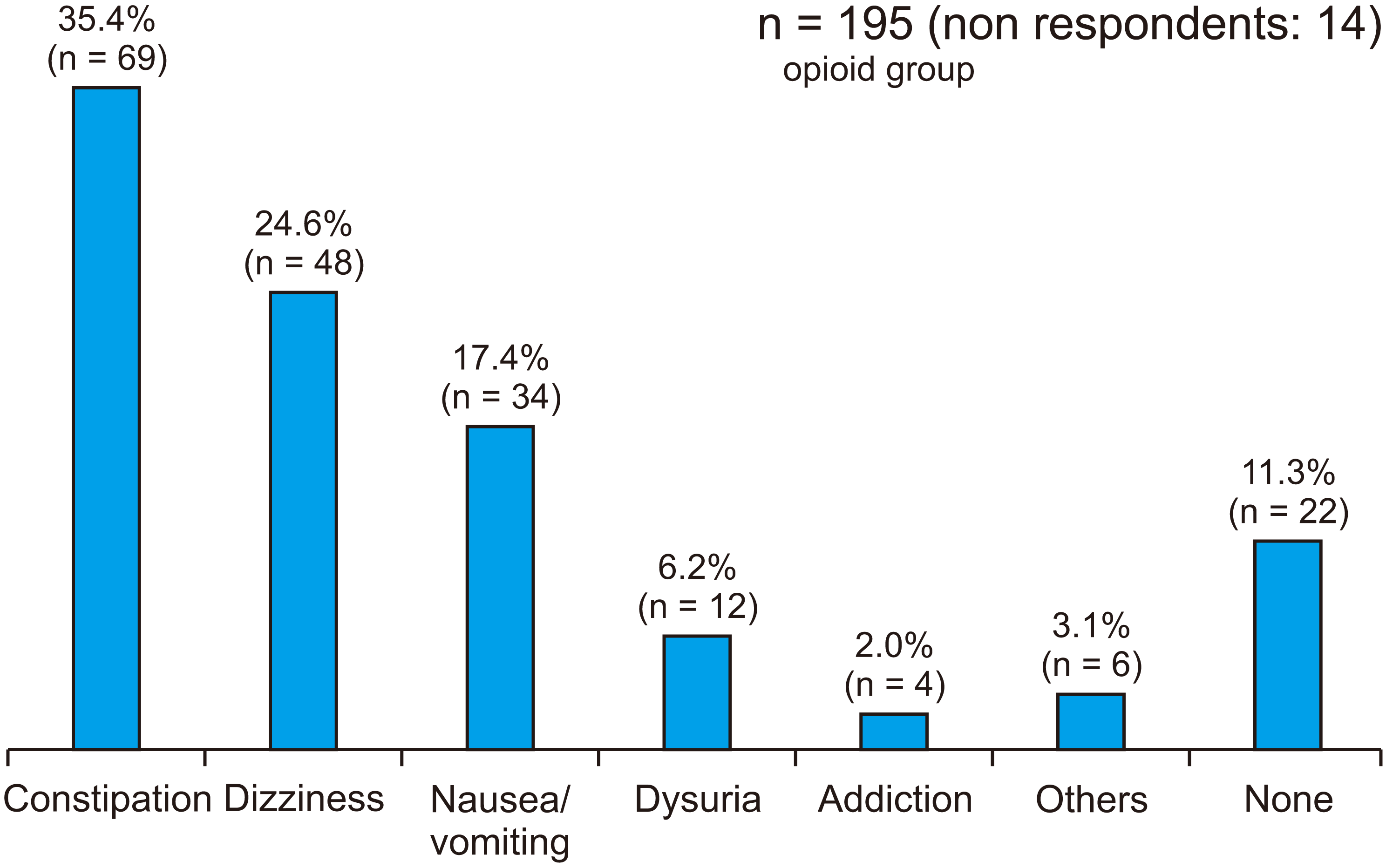

Fig. 3
(A) Did your doctor ask you regarding opioids and explain their side effects? (asked in the opioid group). (B) What is your perception regarding opioid medication? (asked in the opioid group).
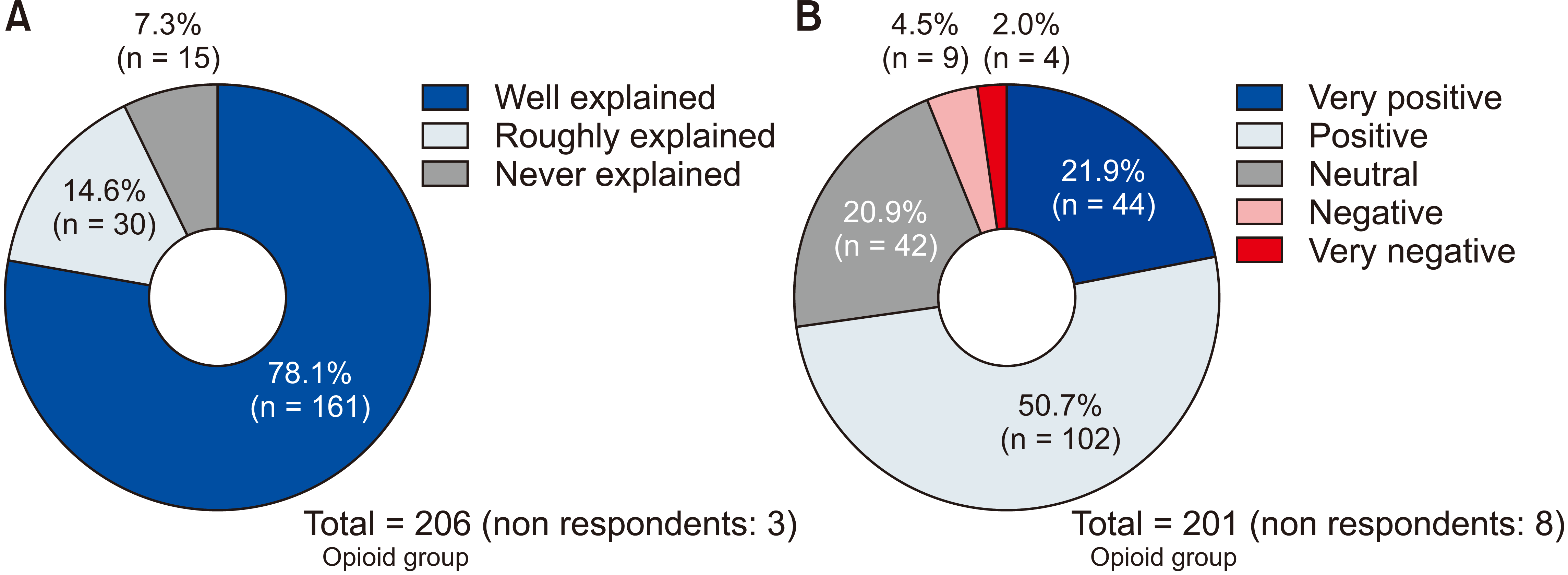

Fig. 4
(A) In Korea, public health insurance provides coverage for the prescription of opioids up to 30 days for the non-cancer pain treatment. What is your opinion regarding this limit? (asked in the opioid group). (B) If you think this limit should be increased, then please tell us why? (C) If you think this limit should be decreased, then please tell us why?
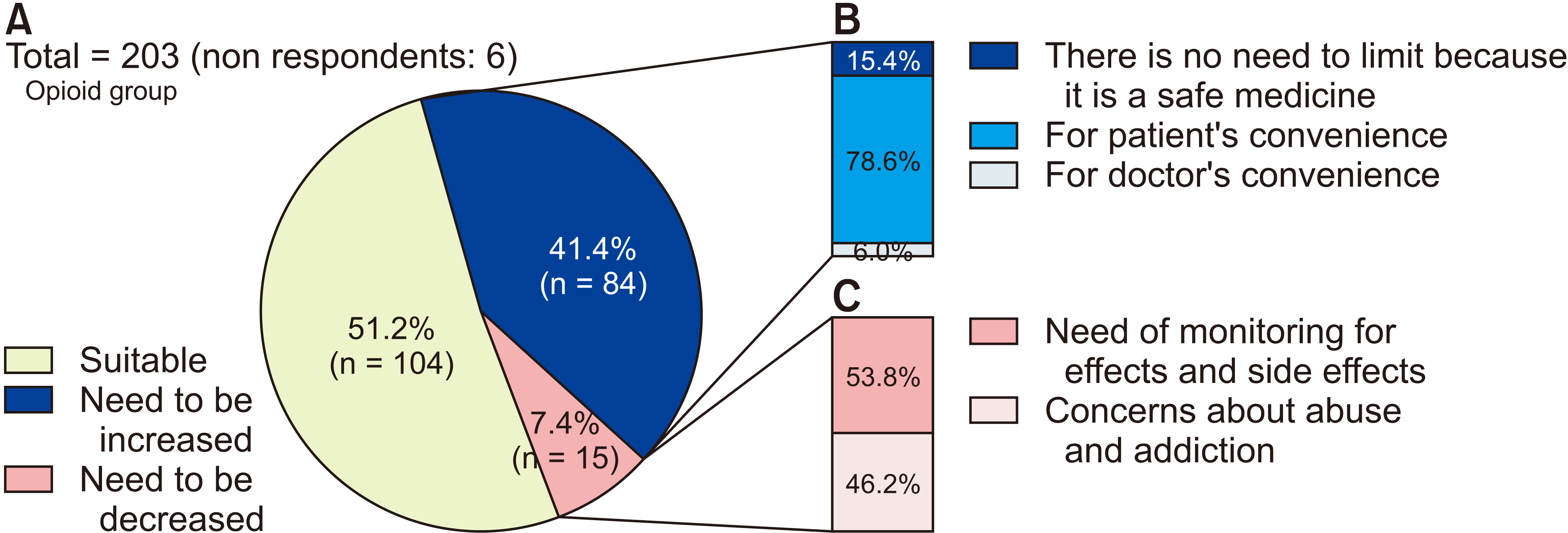

In Korea, public healthcare insurance coverage is possible without the limit on opioid doses for managing cancer pain, but there is a limit on the insurable prescription dose for non-cancer pain management. When patients in the opioid group were asked about the limits on dosage in non-cancer pain, among 183 patients (excluding 26 non-respondents), 70 patients (38.3%) thought they are suitable, 102 (55.7%; complex regional pain syndrome [CRPS], 38 patients; postherpetic neuralgia, 6 patients; peripheral neuropathy, 8 patients; fibromyalgia, 9 patients; cancer pain, 3 patients; spinal or joint pain, 33 patients; patients who didn’t answer their disease, 5 patients) thought that insurable prescription dosages need to be increased, and 11 patients (6.0%) thought that insurable prescription dosages need to be decreased. When they were asked about reasons why they thought it should be increased, 16 respondents (16.2%) said that opioids are safe, 31 (31.3%) responded that analgesic effects decreased with time due to development of drug resistance, 48 (48.5%) responded that such insurance policies put financial burdens on the patient, and 4 (4.0%) cited others reasons (excluding 3 non-respondents). The patients who thought it should be reduced cited concerns with abuse and addiction (n = 7, 63.6%) and need for monitoring of effects and side effects (n = 4, 36.4%) as reasons (
Fig. 5).
Fig. 5
(A) In Korea, public health insurance provides coverage for opioid prescription for pain treatment. Insurance covered opioid dosage is non-restricted for the cancer pain treatment, but it is limited for the non-cancer pain treatment. What is your opinion regarding this limit on opioid dosage? (asked in the opioid group). (B) If you think insurable prescription dosages should be increased, then please tell us why? (C) If you think insurable prescription dosages should be decreased, then please tell us why?
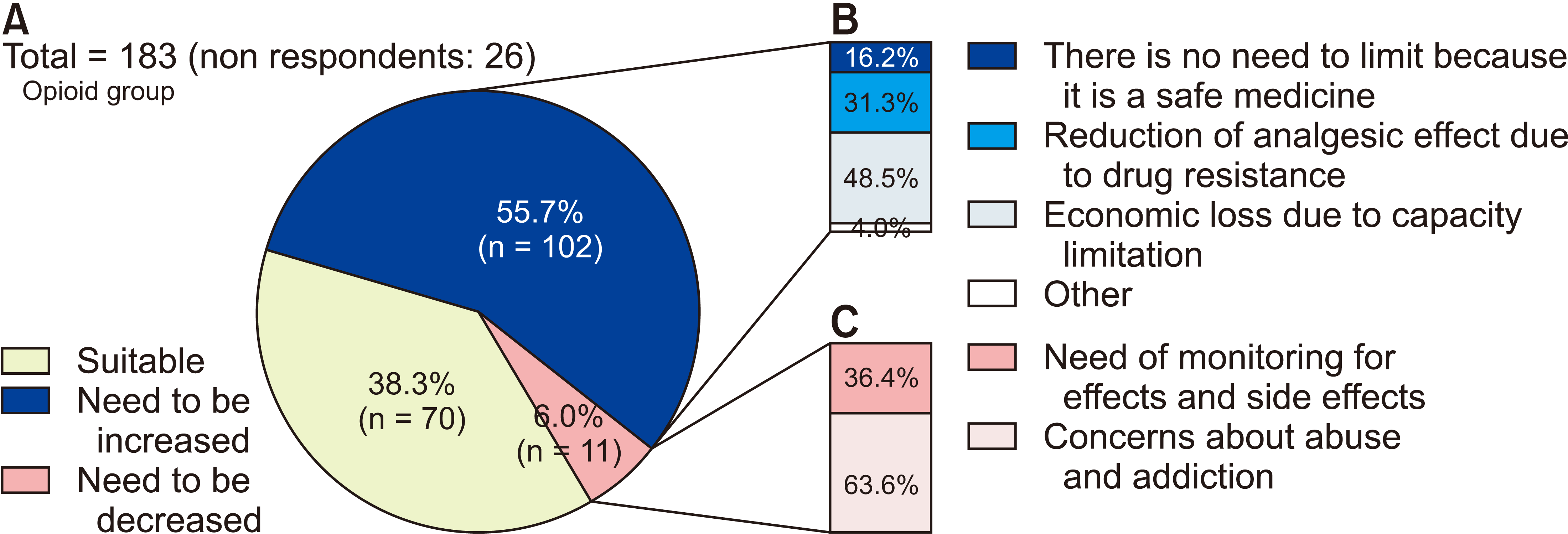

According to 146 patients in the no opioid group (excluding 13 non-respondents) who were prescribed opioids for their treatment, 89 (61.0%) said that they would take them and 57 (39.0%) said they would not. The reasons cited for refusal (n = 52, excluding 5 non-respondents) were fear of addiction (n = 30, 57.7%), fear of side effects (n = 20, 38.5%), and other (n = 2, 3.8%) (
Fig. 6). When 130 patients of the no opioid group (excluding 29 non-respondents) were asked about their source of information about opioids, 64 (49.2%), 40 (30.8%), 21 (16.2%), and 5 (3.8%) said from doctors, mass media, the internet, and friends, respectively (
Fig. 7).
Fig. 6
(A) If your physician informs you regarding the requirement to prescribe opioids for pain control, would you consume them? (asked in the no opioid group). (B) If you deny, then please tell us why?
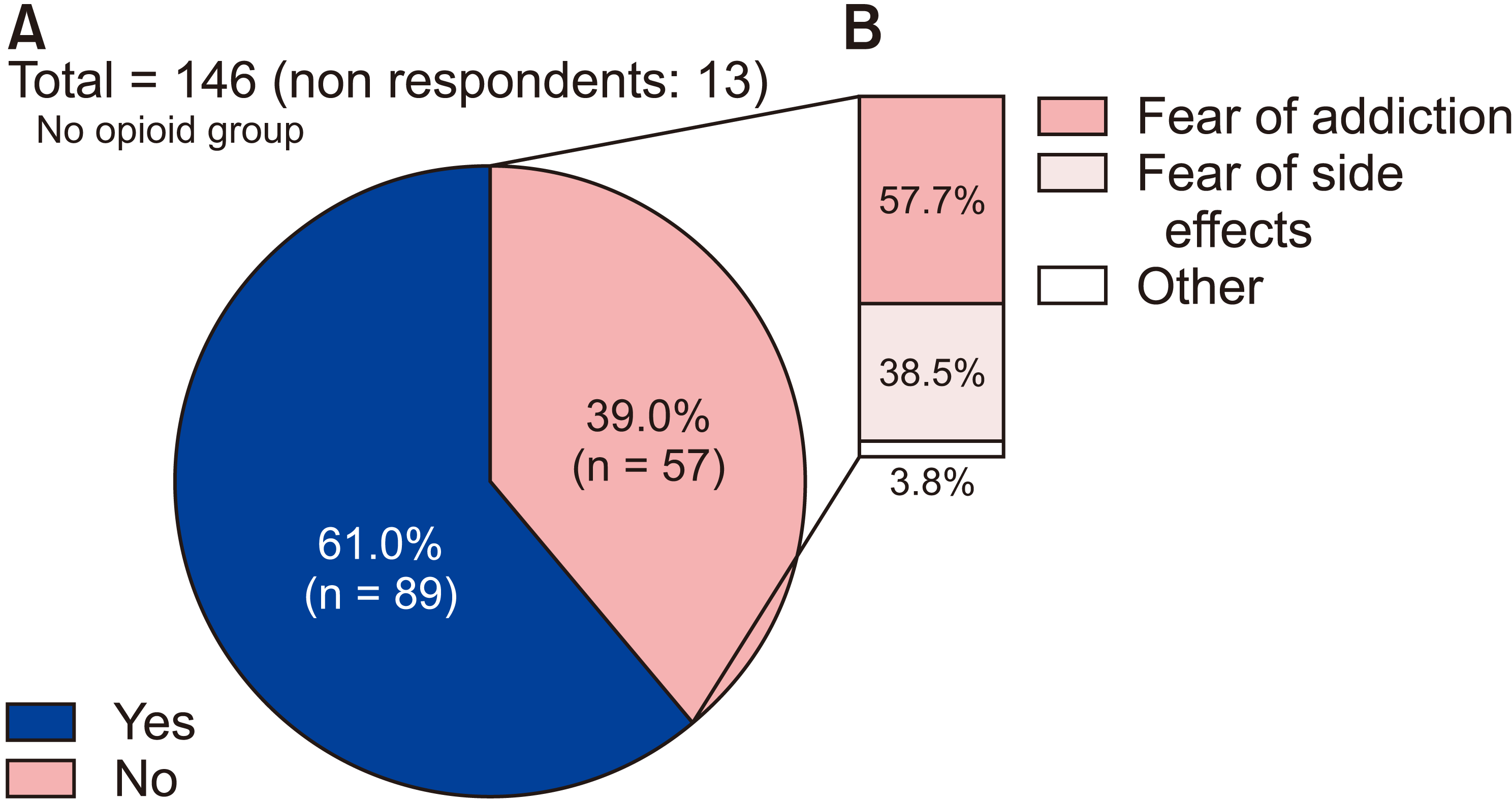

Fig. 7
What is your source of opioid information? (asked in the no opioid group).
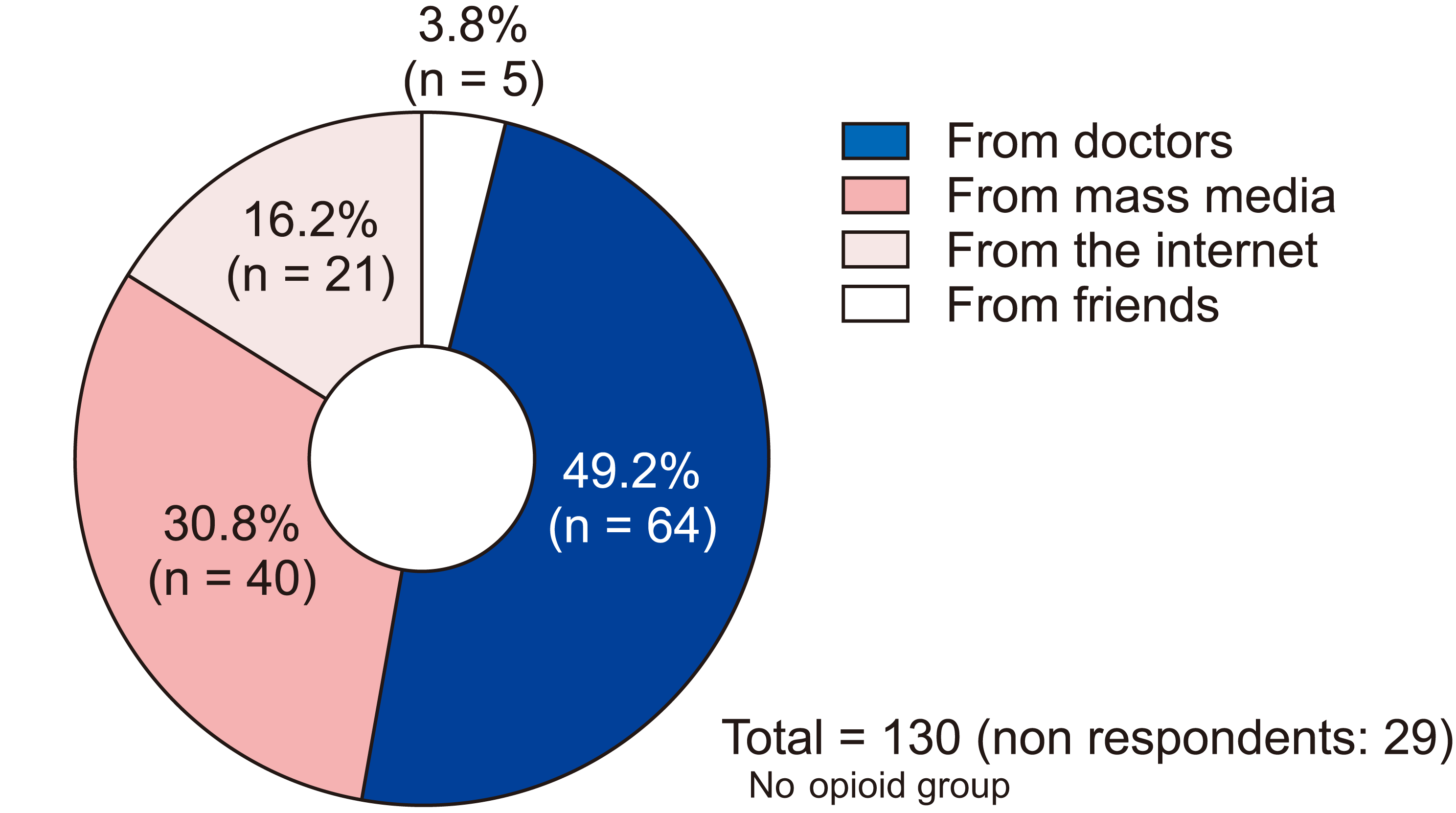

Both the opioid and no opioid groups were asked whether they knew that there are differences between medically prescribed opioids and illegally distributed drugs. Among 194 patients in the opioid group (excluding 15 non-respondents), 145 respondents (74.7%) said that they knew and 49 (25.3%) said they did not. In contrast, among 154 patients in the no opioid group (excluding 5 non-respondents), 72 respondents (46.8%) knew and 82 (53.2%) did not (
Fig. 8). When asked about the pain score at which they would start taking opioids if they were prescribed (0 means no pain and 10 means the most severe pain imaginable), among 193 patients in the opioid group (excluding 16 non-respondents), 138 (71.5%), 29 (15.0%), 16 (8.3%), 4 (2.1%), and 4 patients (2.1%) replied ≥ 7, 6, 5, 4, and 3 points, respectively. Only 2 patients (1.0%) replied that they would never take opioids. On the other hand, among 151 patients in the no opioid group (excluding 8 non-respondents), 92 (60.9%), 23 (15.2%), 10 (6.6%), 0 (0%), and 6 patients (4.0%) replied ≥ 7, 6, 5, 4, and 3, respectively, whereas 20 patients (13.3%) replied that they would never take opioids (
Fig. 9).
Fig. 8
Did you know that differences between medically prescribed opioids and illegally distributed drugs exist? (asked in both the opioid groups).
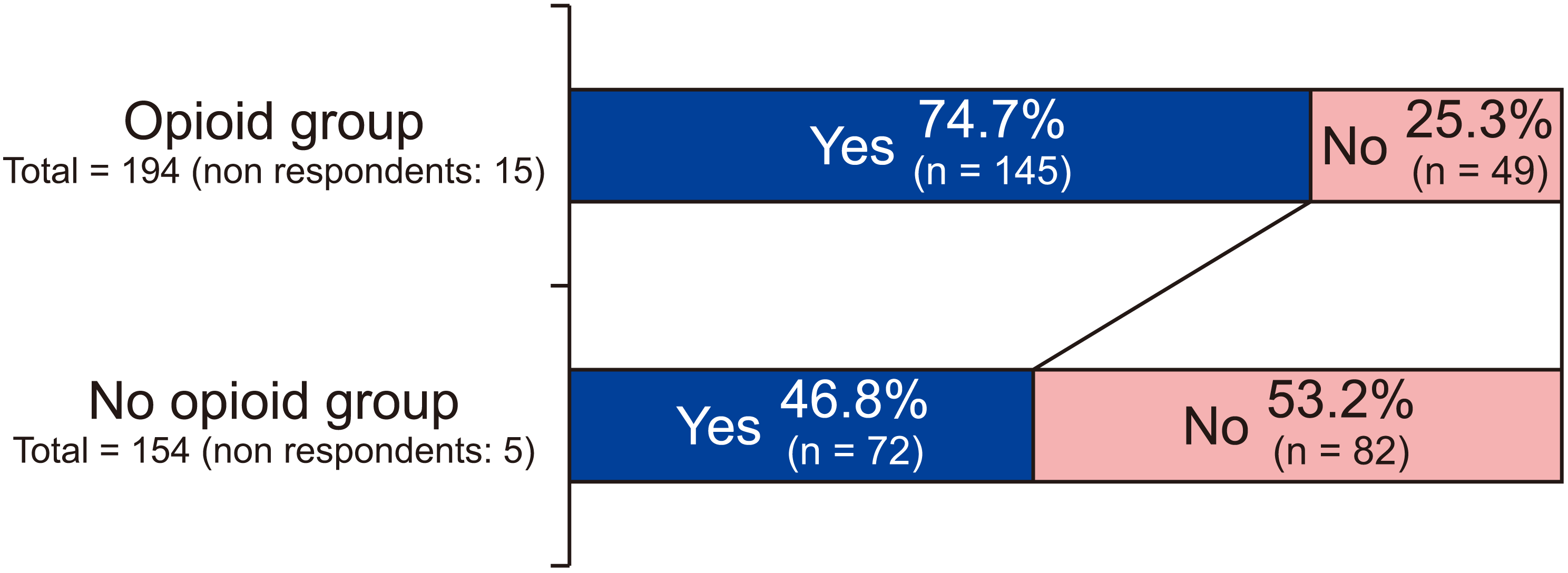

Fig. 9
What is the pain score at which you would start taking opioids if they are prescribed? (asked in both the opioid groups).
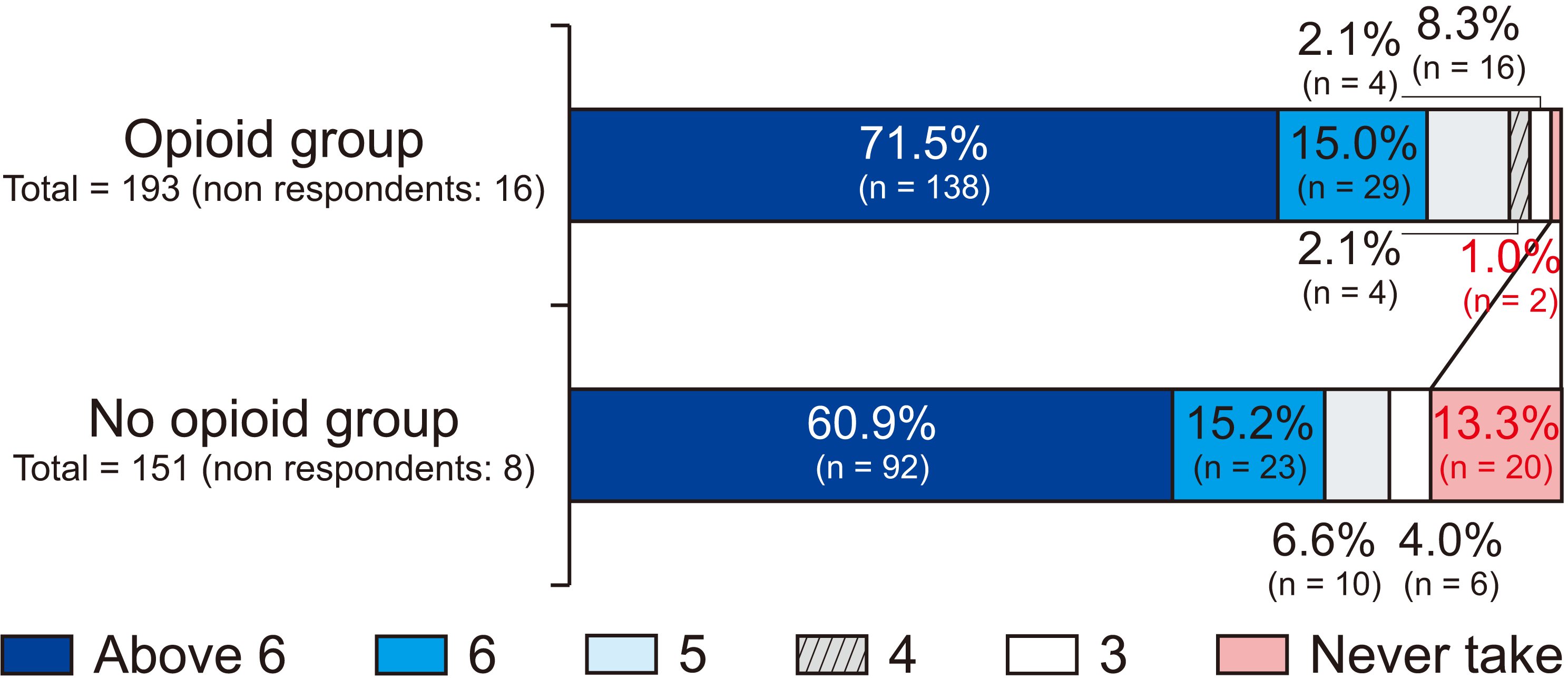

DISCUSSION
Medical opioid consumption has increased worldwide [
16]. Just as in Europe and North America, opioid use has increased in South Korea as well [
13,
14]. This survey revealed that many patients who were prescribed opioids at the pain clinic were those who experienced chronic non-cancer pain (CNCP). Globally, doctors have struggled for a long time to treat CNCP because it can cause severe intractable pain, and reduces the quality of life. Doctors believe that the non-opioid treatment is limited, and thus, opioids [
16,
17], which are mainly used for treating severe acute pain, postsurgical pain, and cancer pain, should be considered for the treatment [
18]. The efficacy of opioids has been proven in studies on short-term opioid treatment for CNCP [
19,
20]. Although there was still debate about long-term opioid treatment for CNCP, The Cochrane Database of Systematic Reviews 2010 concluded that, despite the fact that pain relief varies from one study to another, long-term opioid therapy is clinically significant for CNCP [
18]. There is also both moderate/high- and low-quality evidence suggesting that long-term opioid medication can lead to significant improvements in functional outcomes, including quality of life, in patients with CNCP.
Many studies have revealed the clinical benefits of opioid treatment on CNCP, but it should be used with caution. Some studies have expressed concerns about the safety of long-term opioid treatment, its side effects, and risk of addiction [
17]. In this study, constipation, dizziness, nausea, and vomiting were found to be the most common side effects of opioids. Meta-analysis reported the following side effects of opioid medication: constipation (10%-22%), nausea (11%-19%), dizziness or vertigo (5%-12%), somnolence or drowsiness (5%-13%), vomiting (2%-7%), and dry skin, itching or pruritus (1%-6%) [
19].
In the opioid group, 2.0% of patients experienced the side effect of addiction. In the no opioid group, many patients who avoided opioids presented a concern regarding addiction. The subject of potential harms like misuse, abuse, and addiction should not be overlooked. Unlike other drugs, physiological dependence can arise in virtually all patients who are treated with chronic opioid therapy [
21]. Several studies have been conducted on opioid addiction. In each study, the intoxication rate had been suggested to be from less than 1% to 3.3%, and up to 4.4% among patients without prior opioid exposure [
18,
22-
24]. Thinking broadly beyond addiction to aberrant drug-related behaviors, recent rigorous studies have revealed that opioid use disorders occur in up to one-third of the patients receiving chronic opioid treatment [
25]. Using the Opioid Risk Tool which includes questions about family history of substance abuse, personal history of substance abuse, age, history of preadolescent sexual abuse, and psychological disease, physicians can predict the probability of a patient displaying aberrant behaviors when opioids are prescribed for chronic pain [
26]. Korean guidelines for opioid therapy for CNCP include administering a screening questionnaire for the possibility of opioid addiction before prescribing opioids [
27]. Tools determining the risk of opioid addiction, if properly validated, would allow physicians to differentiate between patients who can be safely prescribed a long-term opioid therapy and those in whom the benefits are likely to be outweighed by the risks of the chronic opioid therapy [
25]. Appropriate opioid prescription in selected patients, after careful identification of the opioid addiction risk, can minimize the risk of overdose, misuse, and addiction [
28]. The Korean guidelines for opioid therapy for CNCP include identifying a patient’s overall physical and addiction status prior to opioid prescription, obtaining informed consent and consent for opioid treatment, and selecting the type and amount of the selected drug for each stage of pain [
27]. If doctors follow these treatment guidelines, they can use opioids with maximum benefit and minimal harm.
This survey was conducted to investigate a patient’s perception regarding opioids and the insurance-associated limitations in Korea. Most patients in the opioid group had a neutral (20.9%) or positive (72.6%) perception of opioids. Only 6.5% of patients had negative perceptions. Although perception regarding opioids were not sought from the no opioid group patients, it was found that they had a considerably more negative perception than the opioid group patients. Thirty-nine percent of patients in the no opioid group said that they would not take opioids even if their physician prescribed them due to fear of addiction and side effects. This indicates that negative perceptions regarding opioids can lead patients to refuse opioid medication. A total of 71.5% and 60.9% patients in the opioid and no opioid groups, respectively, had a view that opioid medication must be consumed for a pain score of NRS 7 or higher. According to the Korean guidelines for opioid therapy for CNCP, opioid use may be considered the first-line treatment for patients experiencing severe pain [
27]. NRS 7 and above is considered severe pain in patients with CNCP [
29]. Hence, this can be one of the factors based on which doctors can decide whether to prescribe opioids. In the no opioid group, although 39.0% patients refused opioid prescription, 86.7% patients would start opioid medication based on their pain score. Therefore, a doctor can prescribe opioid medication with sufficient explanation to patients with severe pain. More than half of the patients in the no opioid group had obtained information regarding opioids from sources other than doctors. In the opioid group, 7.2% of the patients did not receive any explanation regarding opioids from their doctor. Although the rate was low in the opioid group, doctors should not forget to explain the opioid medication and its effect/side effects to their patients.
The difference between illegally distributed drugs and medically prescribed opioids was known to 74.7% patients in the opioid group but only to 46.8% patients in the no opioid group. Possibly, more than half of the patients in the no opioid group believed that opioid medication is as dangerous as illegally distributed drugs. This belief can be related to the fear of addiction and side effects (
Fig. 6). The fear can be a barrier to the use of opioid medication.
According to public healthcare insurance system in Korea, the prescription days of opioids are limited to 1 month, and the insurable dose of opioids are limited for non-cancer pain. In the opioid group, more patients (51.2%) thought that the limited prescription days are appropriate. However, 41.4% of patients thought that the limitation on prescription days was too severe, and needed to be increased for improved patient convenience and the opioid medication’s safe usage. More patients (55.7%) in the opioid group thought that the limited dosage of opioids should be increased for non-cancer pain. Especially 50% of CRPS patients thought that the limited dosage of opioids should be increased. This may be related to the insufficient effect of the limited dose of opioids in severe pain patients.
This study has some limitations. First, this investigation was conducted among patients who agreed to the survey. Patients who disagreed with the questionnaire may have had a reason to be reluctant to do so. If it is due to an addiction to, or refusal of opioids, it should be considered in the interpretation of this investigation. Unfortunately, the number of people excluded due to the rejection of the questionnaire was not counted. Second, statistical analysis comparing the opioid and no opioid groups was not performed in this survey study. Hence, a comparative study in the future is warranted. Third, this survey included patients who agreed to it at the pain clinic, and thus, patients at a high risk of addiction were not excluded. Therefore, bias associated with opioid addicts’ opinions regarding an increase in insurable days and dose may exist. However, not all 55.7% of the patients would have been addicts, and hence, we believe that the bias may be low. Only 2.0% of patients mentioned addiction as a side effect. To determine whether a patient is addicted, a doctor’s opinion regarding the patient is crucial. Hence, future investigation on addiction must consider patients’ as well as doctors’ opinions.
In conclusion, this survey suggests that some patients have fears regarding opioid medication, related addiction, and side effects. However, the perception of opioids in most patients who are taking them was either neutral or positive. More patients in the opioid group and half of CRPS patients thought that the limited dosage of opioids should be increased for non-cancer pain. Even if opioids may be needed for severe pain patients, doctors should consider patient concerns regarding abuse or addiction before prescribing opioids.







